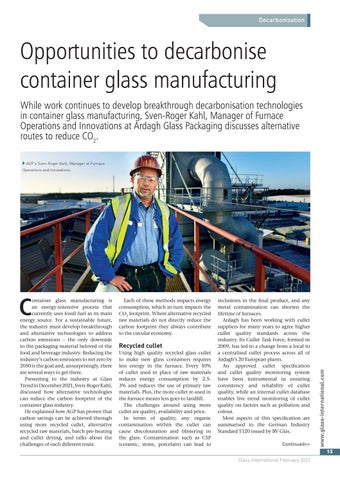Decarbonisation
Opportunities to decarbonise container glass manufacturing While work continues to develop breakthrough decarbonisation technologies in container glass manufacturing, Sven-Roger Kahl, Manager of Furnace Operations and Innovations at Ardagh Glass Packaging discusses alternative routes to reduce CO2. � AGP’s Sven-Roger Kahl, Manager of Furnace
C
ontainer glass manufacturing is an energy-intensive process that currently uses fossil fuel as its main energy source. For a sustainable future, the industry must develop breakthrough and alternative technologies to address carbon emissions – the only downside to the packaging material beloved of the food and beverage industry. Reducing the industry’s carbon emissions to net zero by 2050 is the goal and, unsurprisingly, there are several ways to get there. Presenting to the industry at Glass Trend in December 2021, Sven-Roger Kahl, discussed how alternative technologies can reduce the carbon footprint of the container glass industry. He explained how AGP has proven that carbon savings can be achieved through using more recycled cullet, alternative recycled raw materials, batch pre-heating and cullet drying, and talks about the challenges of each different route.
Each of these methods impacts energy consumption, which in turn impacts the CO2 footprint. Where alternative recycled raw materials do not directly reduce the carbon footprint they always contribute to the circular economy.
Recycled cullet Using high quality recycled glass cullet to make new glass containers requires less energy in the furnace. Every 10% of cullet used in place of raw materials reduces energy consumption by 2.53% and reduces the use of primary raw materials. Plus, the more cullet re-used in the furnace means less goes to landfill. The challenges around using more cullet are quality, availability and price. In terms of quality, any organic contamination within the cullet can cause discolouration and blistering in the glass. Contamination such as CSP (ceramic, stone, porcelain) can lead to
inclusions in the final product, and any metal contamination can shorten the lifetime of furnaces. Ardagh has been working with cullet suppliers for many years to agree higher cullet quality standards across the industry. Its Cullet Task Force, formed in 2009, has led to a change from a local to a centralised cullet process across all of Ardagh’s 20 European plants. An approved cullet specification and cullet quality monitoring system have been instrumental in ensuring consistency and reliability of cullet quality, while an internal cullet database enables live trend monitoring of cullet quality on factors such as pollution and colour. Most aspects of this specification are summarised in the German Industry Standard T120 issued by BV Glas. Continued>>
www.glass-international.com
Operations and Innovations.
13 Glass International February 2022
Ardagh.indd 1
16/02/2022 10:47:45










